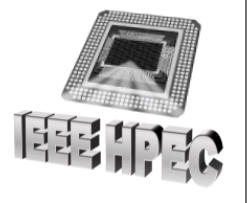








2015 IEEE High Performance
Extreme Computing Conference
(HPEC ‘15)
Nineteenth Annual HPEC Conference
15 - 17 September 2015
Westin Hotel, Waltham, MA USA


Extreme Form Factors
1:00-2:40 in Eden Vale A3
Chair: Ken Gregson / MIT Lincoln Laboratory
Invited Talk: SpaceVPX Embedded Computing to Meet the Demands of Space
Dr. Charles Patrick Collier, Air Force Research Laboratory
Invited Talk: TBD
Prof. Sertac Karaman, Dept of Aero/Astro - MIT
Invited Talk: The IEEE Rebooting Computing Initiative
Prof. Tom Conte, Georgia Tech - President IEEE Computer Society
Invited Talk: Standards to Facilitate Open Architecture and a COTS Ecosystem
Mr. Greg Rocco / MIT Lincoln Laboratory, Dave Tremper / Office of Naval Research
Agile Condor: A Scalable High Performance Embedded Computing Architecture
Mark Barnell, Courtney Raymond, Air Force Research Lab, Christopher Capraro, Darrek Isereau, SRC
The Air Force Research Laboratory Information Directorate Advanced Computing and Communications Division is developing a
new computing architecture, designed to provide high performance embedded computing (HPEC) pod solution to meet
operational and tactical real-time processing intelligence surveillance and reconnaissance (ISR) missions. This newly designed
system, Agile Condor, is a scalable and HPEC system based on open industry standards that will increase, far beyond the
current state-of-the-art, computational capability within the restrictive size, weight and power constraints of unmanned aircraft
systems’ external “pod” payloads. The objective with such a system is to explore and develop innovative system solutions to
meet future Air Force real-time HPEC; e.g., multi-mission, multi-function ISR processing and exploitation. While the core
compute capability can be placed in various environments, our baseline design utilizes a 12-inch diameter flight-certified
aeronautics pod that is scalable in length. Agile Condor can be connected to external data sources, or the nose and tail can be
made of Radio Frequency (RF) transparent material, enabling the use of various RF sensing technologies within the same
aeronautics enclosure. Inside this pod is a lightweight, thermally-efficient industry standard 3U VPX conduction cooled (with
unconditioned ambient air) chassis that supports the required board and interface hardware. Agile Condor brings high-
performance computing closer to sensors and immediately enables future research and development efforts in neuromorphic
computing and autonomous system operations.
Wednesday September 16





2015 IEEE High Performance
Extreme Computing Conference
(HPEC ‘15)
Nineteenth Annual HPEC Conference
15 - 17 September 2015
Westin Hotel, Waltham, MA USA


Extreme Form Factors
1:00-2:40 in Eden Vale A3
Chair: Ken Gregson / MIT Lincoln Laboratory
Invited Talk: SpaceVPX Embedded Computing to
Meet the Demands of Space
Dr. Charles Patrick Collier, Air Force Research
Laboratory
Invited Talk: TBD
Prof. Sertac Karaman, Dept of Aero/Astro - MIT
Invited Talk: The IEEE Rebooting Computing
Initiative
Prof. Tom Conte, Georgia Tech - President IEEE
Computer Society
Invited Talk: Standards to Facilitate Open
Architecture and a COTS Ecosystem
Mr. Greg Rocco / MIT Lincoln Laboratory, Dave Tremper /
Office of Naval Research
Agile Condor: A Scalable High Performance
Embedded Computing Architecture
Mark Barnell, Courtney Raymond, Air Force Research
Lab, Christopher Capraro, Darrek Isereau, SRC
The Air Force Research Laboratory Information
Directorate Advanced Computing and
Communications Division is developing a new
computing architecture, designed to provide high
performance embedded computing (HPEC) pod
solution to meet operational and tactical real-time
processing intelligence surveillance and
reconnaissance (ISR) missions. This newly
designed system, Agile Condor, is a scalable and
HPEC system based on open industry standards
that will increase, far beyond the current state-of-
the-art, computational capability within the
restrictive size, weight and power constraints of
unmanned aircraft systems’ external “pod”
payloads. The objective with such a system is to
explore and develop innovative system solutions to
meet future Air Force real-time HPEC; e.g., multi-
mission, multi-function ISR processing and
exploitation. While the core compute capability can
be placed in various environments, our baseline
design utilizes a 12-inch diameter flight-certified
aeronautics pod that is scalable in length. Agile
Condor can be connected to external data sources,
or the nose and tail can be made of Radio
Frequency (RF) transparent material, enabling the
use of various RF sensing technologies within the
same aeronautics enclosure. Inside this pod is a
lightweight, thermally-efficient industry standard 3U
VPX conduction cooled (with unconditioned
ambient air) chassis that supports the required
board and interface hardware. Agile Condor brings
high-performance computing closer to sensors and
immediately enables future research and
development efforts in neuromorphic computing
and autonomous system operations.
Wednesday September 16















